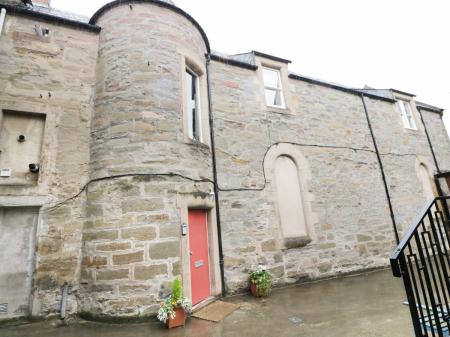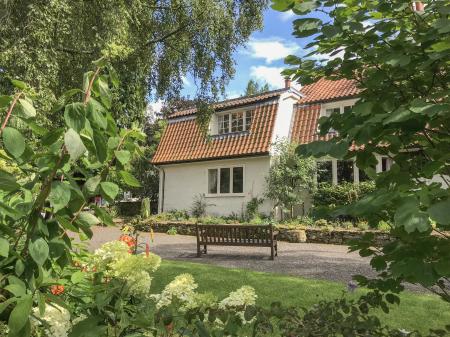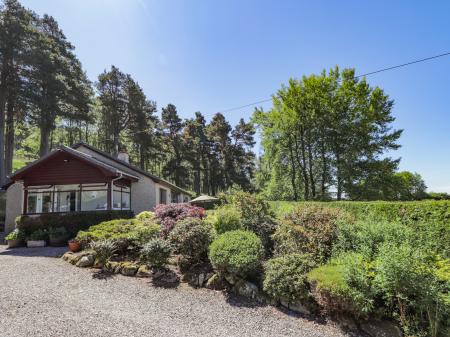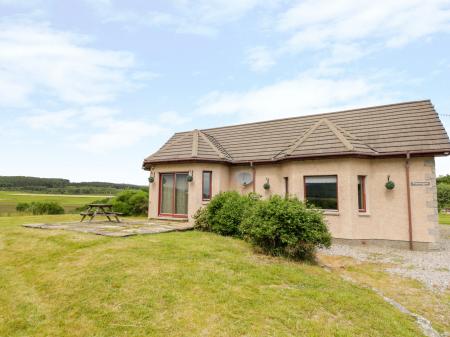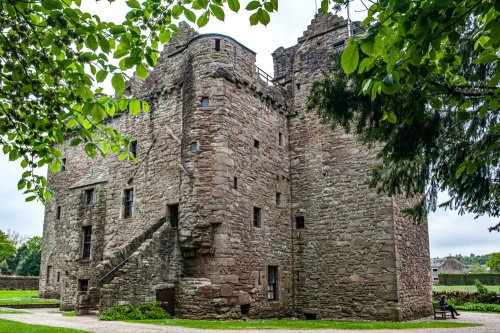
History
Huntingtower was begun by the Ruthven family, who first came to Perthshire in the 12th century. The exact circumstances of how they came to build Huntingtower is not clear, but in 1480 the sons of the 1st Lord Ruthven were each granted letters of legitimation, a recognition of their rights in law to inherit. So perhaps one tower house was built for each of the Lord's sons.
The letters must have been retrospective, for the east tower appears to have been built around 1460, with the west added in 1480. The second tower must have been the main lodging, for it is larger and more elaborate, built to an L-plan. This was linked to a great hall, where feasting would have taken place.
At that time the house, or houses, was known as The Place of Ruthven. The two tower houses were only 3 metres apart, and were surrounded by other buildings, including the hall, chapel, and gallery, ranged around a courtyard. The entire site was enclosed by a sturdy stone wall, adding to the defensive strength of the site.

The Ruthven Raid
The Ruthven family played a major role in political events if the late-16th century in Scotland. Mary, Queen of Scots stayed here in 1565, and again in 1582 during her honeymoon with her ill-fated second husband, Lord Darnley. In 1581 James VI made the 4th Lord Ruthven Earl of Gowrie.
The new Earl had a peculiar way of showing his gratitude; in 1582 the Earl held the king prisoner here, an episode known as the Ruthven Raid. The Earl and his co-conspirators, including the Earl of Mar, wanted to remove the young James from the influence of the Duke of Lennox and the Earl of Arran. For 10 months King James was held at the Place of Ruthven, while the Earl and his fellow conspirators held the reigns of power.
The king somewhat surprisingly forgave the Earl at first, but the Earl of Arran soon had James under his control again, and Gowrie was told to leave Scotland. But before he could take ship the Earl was arrested, tried, and executed for treason. The Earl of Arran's triumph was short-lived, for he himself met the same fate in the following year.

However, Ruthven family was not finished with conspiracies. In 1600 the 3rd Earl took part in the Gowrie Conspiracy to oust the king, and this time the king was not so forgiving; the Earl was executed and his estates seized.
James gave the Place of Ruthven to the Murray family of Tullibardine, and it was the Murrays who renamed the property Huntingtower. They also joined the two tower houses to make one large building and remodelled it to create an imposing mansion, built for comfort and prestige rather than defence.
The Murrays left many of the earlier medieval features intact, including a painted ceiling that is one of the earliest survivors in Scotland. Traces of wall paintings also remain, giving a sense of how luxurious the house must have looked during the Ruthven's residence.

The ground floor was probably used as a laigh hall, a place where servants gathered for meals. Above that was the lord's hall, an ostentatious reception room, with ornate decoration meant to impress guests. Above the hall was the lord's chamber; a withdrawing room, housing a large four-poster bed. From the lord's chamber stairs rise still further to an attic used for servant's quarters and storage.

Maiden's Leap
Not all famous events at Huntingtower involves kidnap of kings! One of the most famous episodes involves Dorothea, daughter of the 1st Earl of Gowrie. The Earl's daughter snuck from her tower bedroom to the bedchamber of her lover, John Wemyss, in the other tower.
A servant alerted the Countess to the affair, and the Countess mounted the stairs to the lover's bedchamber in anger to see if the tales were true. Desperate not be caught, the Earl's daughter leapt the gap between the two towers and ran down the stairs to the safety of her own bedroom. That leap spanned a distance of almost 10 feet. In the dark.
When the Countess arrived at the young man's chambers, her daughter was nowhere to be seen. The Countess apologised and went to check on her daughter. When she climbed to her daughter's chamber she found Dorothea in bed, seemingly fast asleep. From that day forward the gap between the two towers has been known as Maiden's Leap.
As an aside, the pair of lovers were eventually married and lived an apparently happy life together. When you see the gap between the towers, even in broad daylight, it seems staggering to think that anyone would try to leap the span!

The Jacobite Connection
Huntingtower has strong links to the Jacobite Rebellions; it was here in 1694 that Lord George Murray was born to John Murray, Earl of Atholl, and his first wife Katherine. Lord Murray grew up to become a leader of the Jacobite cause and served as Bonnie Prince Charlie's general at Culloden when the Jacobite dream finally died.
The final member of the family to live at Huntingtower was Mary, 2nd wife of the Earl, who died here in 1767. The house was sold in 1805 to James Buchan, a wealthy businessman, who used it to house workers for his cloth-printing factory.
Visiting
Huntingtower is very well signposted, with easy access off the A85, just north of Perth. There is parking just below the castle, with a shop and visitor centre. There are no grounds to speak of, but the two towers that make up the castle will take plenty of time to explore; around every corner there seems to be another chamber or staircase.
Our family really enjoyed visiting. The thing that really sticks my mind is the Maiden's Leap. How on earth did Dorothea manage to leap the gap between the two towers?





 We've 'tagged' this attraction information to help you find related historic attractions and learn more about major time periods mentioned.
We've 'tagged' this attraction information to help you find related historic attractions and learn more about major time periods mentioned.